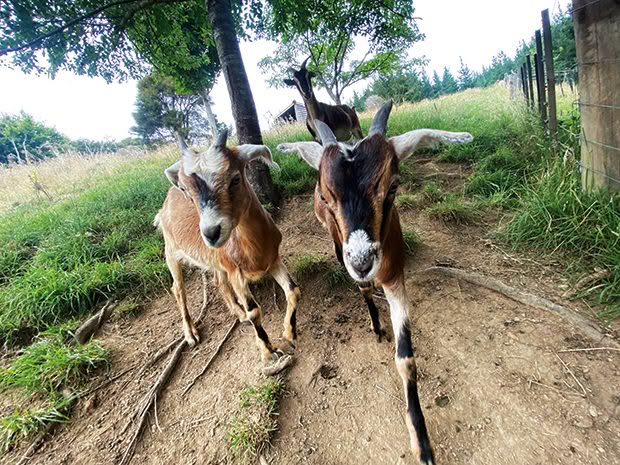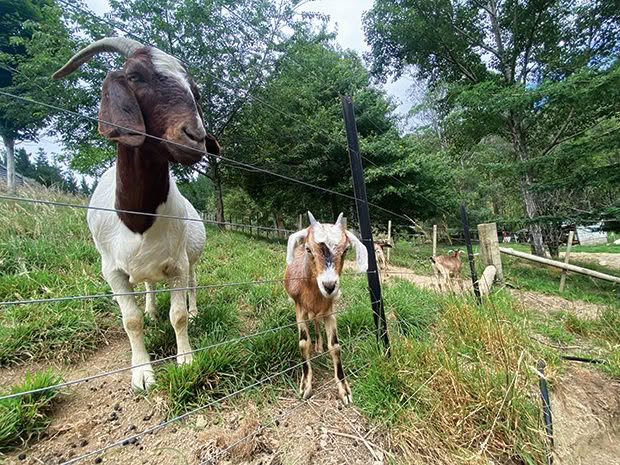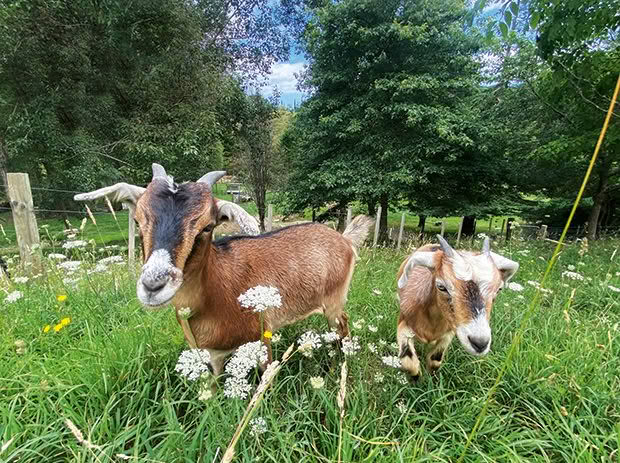The art of maintaining and containing rescue goats

There’s an art to keeping goats, and it usually involves a stupendous amount of fencing. In part two, Naomi Arnold recounts the experience of containing two goats she adopted from the SPCA.
Words: Naomi Arnold
There’s no point complaining to friends, family and neighbours about your goats escaping. Every single response you’ll get will be a version of: “If it can’t hold water, it won’t hold a goat.” This may be true, but like most responses to complaints, entirely unhelpful.
The escape yarns are the most entertaining posts on the NZ Goat Talk Facebook page, where there are dozens of stories from goat owners at their wits’ end with their enterprising animals. Goats getting through four-wire mains electric fences. Goats clambering up deer fencing and sidling up fence stays. A pair called Martha and Hugo escaped at night and climbed all over their owner Emma’s ute, causing a right mess and breaking off a wing mirror; the insurance claim form came addressed to the “Naughty little goats”. Another had headbutted a car’s radar unit, breaking the windscreen.
After Nelson’s huge winter storm flooded out our new baby rescue goats, Buckley and Scooter, we piled hay onto our brick patio and let them stay there for a week until the rain eased, the water drained away, and we could get them set up in a new pen. They were a welcome source of light relief, and embedded themselves into our daily routine, running at our heels whenever we squelched about the property to investigate the next round of flooding or tree damage. But I had a feeling this was going to prove a problem when we eventually evicted them from the patio and into a new pen.
Sure enough, the first time we left the pair in their new housing, Buckley in particular was outraged at being split from the family. He climbed the wires, pushed through the wires, went under the wires. He jumped onto the tarpaulin we’d rigged for sun shelter, staggered across it and leaped over the fence. As soon as we fixed one weak point, he’d find another. When we set up hotwires, the leggy little gymnast simply learned to walk back, run up, and soar over them.
We hadn’t yet experienced goat escapees until these two came along. We already had a Boer and an ex-feral, Brian and Stephen – much older goats that kept the gorse and weeds down and were happy to be contained behind their ordinary seven-wire fence. Not Buckley. His bleating was the most distressingly human-like sound I have ever heard. We got heart palpitations from it. Our poor, patient neighbour kept thinking there was a wailing child lost somewhere. The SPCA had told me the goats were just about weaned, but Buckley’s constant abscondment to get milk from us proved this wasn’t the case.
We built a new bigger, taller pen. Then another, this time attached to the big goats’ paddock, hoping that would provide enough entertainment and company to keep Buckley in. The big goats were content to browse peaceably in each other’s company – maybe Buckley would take the hint.

He did not. Although he liked headbutting his new brothers through their fence, he spent the rest of the time figuring out how to escape so he could clatter down to the house to trot at our heels again. I spent entire days coming up with new ways to keep him contained. But he couldn’t cope with seeing or hearing us walk past and being unable to follow.
This went on for a couple of months, during which time both me and my husband Douglas aged 10 years. The final straw came one afternoon in spring. I was in the garden while Buckley and Scooter grazed in their temporary paddock behind a post-and-rail fence, which had a hot-wire border running a metre back around the interior. Suddenly, Buckley got that look.
“No,” I said, brandishing my secateurs, Buckley sizing me up. “Don’t even think about it.”
Buckley sauntered back, took a running leap, cleared both the electric wire and the wooden fence, and went straight to work on some iris plants. I felt my soul leave my body.
“Right,” I said. “That’s it.”
We’d been waiting until they were a bit bigger to put them in with Brian and Stephen in their hill paddock, but now was the time. They needed a goat family. I put them in with the big boys and we spent the afternoon and evening watching for any issues as we cleared grass, ran a couple of hot wires around the inside of the seven-wire fence and plugged any interesting-looking gaps. But everyone was interacting nicely, so we went to bed and crossed our fingers.
That night, there was no little clatter of hooves on the deck. In the morning, Buckley screeched at 7am as usual, but he didn’t thunder down the hillside as though we’d left him starving for a week. A few days later, we managed to successfully wean them, and now we have our life back.
It took five iterations of enclosure, but our little SPCA rescues now have their forever home. And our original rescue goat Stephen, who’d spent much of his young life alone, finally had some youthful companions. He began to act like a kid again, delighting in the energy of the young ones.
“Stephen never had a family,” my husband said one night as we watched him and the babies kickflip about the paddock.
They’ve all settled down to their daily work: pawing the dust, eating down our grass, gorse, and weeds, and bunting and gallivanting in the afternoon light.
And, most importantly, they haven’t escaped once.

WHY GOATS ESCAPE
Since they were first domesticated 9,500 years ago, goats have been renowned for their ability and tendency to escape from enclosures. Much of this behaviour is driven by instinct – goats are innately curious and agile animals, and they will naturally seek out new areas to browse and explore. But it also has a lot to do with their physicality. Having evolved for millions of years in precipitous mountainous regions of Eastern Europe and the Middle East, wild goats developed the ability to evade predators and find food by climbing, jumping and moving quickly through small spaces. Goats in North Africa have even been observed climbing and standing in trees. Modern domesticated goats have retained these characteristics, hence the difficulty in containing them in flat paddocks and makeshift pens.
While it can be very difficult to physically contain goats, it’s often far simpler to understand the reasons a goat may be escaping, and then come up with an appropriate solution.
INADEQUATE FENCING
The first consideration is adequate fencing. Because goats can jump, climb, push, pull and squeeze through small spaces, fencing needs to be robust, high and safe enough that a goat will not injure itself climbing over it.
• Material: a common choice for goat fencing is woven wire mesh made out of galvanised steel. The squares must be no larger than 10cm2 to prevent goats from putting their heads through – particularly if they have horns. Because this option is more expensive than post-and-batten fencing, it may be more suitable for smaller enclosures.
• Height: goats have been known to jump to a height of up to five feet, so a six-foot-high fence is usually sufficient to contain them.
• Posts: strong corner posts are important to keep the wire taught enough that goats can’t collapse it. For a six-foot-high fence, use eight-foot-long posts buried two feet deep. Place posts and their bracing on the outside of the wire so goats can’t gain a foothold.
• Electric wire: depending on whether your goats are digging or jumping to escape, a hot wire placed at the top of the fence, about a foot inside, or near the bottom of the fence 10cm above ground level, will provide extra protection.
• Barbed wire: this should not be used as goats will not see it as a deterrent and will likely injure themselves trying to climb over it.
LACK OF STIMULUS
Goats will often attempt to escape if they lack stimulation. To satisfy goats’ curiosity and intelligence, their enclosure or environment should:
• be large enough for them to explore and exercise
• include plenty of objects large enough for them to climb and jump on. This might include logs, sturdy huts or sheds, benches, tables or large tyres
• be changed or varied regularly to provide enrichment.
FOOD AND WATER
While other bovids such as cattle and sheep are typically content grazing on grass, goats need variety of food in order to satisfy their need to browse. While they do eat grass, it’s important to also provide the following to reduce the likelihood of escape:
• Good quality hay. According to SPCA New Zealand, this should form half of a goat’s diet and be provided throughout the year.
• Browse and forage. This includes weeds, bushes, shrubs and small trees, for example tagasaste and willow. This should make up 25-50% of the goats’ diet depending on their age and size.
• Chewing material. Because goats love to chew, it can be beneficial to supply them with fruit and vegetables such as pumpkins, watermelon and leafy greens.
• Water. On average, goats drink five to ten litres of water per day. Water should be provided at all times in containers that cannot be knocked over or contaminated with faeces or urine.
SOCIAL INTERACTION
One of the most common motives for a goat escape is a lack of social interaction. They are highly social animals, and the company of other goats is essential for their mental health. One 2021 study published in the Journal of Animal Science found that goats became highly stressed when placed in an open pen out of sight of other goats, crying frequently and trying to escape the pen. Conversely, animals placed in smaller pens but within sight of other goats expressed far fewer cries and were far less stressed.
It’s critical to ensure a goat is never kept in isolation and to remember that other farm animals and humans are not substitutes for the companionship of other goats.
Love this story? Subscribe now!
 This article first appeared in NZ Lifestyle Block Magazine.
This article first appeared in NZ Lifestyle Block Magazine.
